|
Advantech MIO-5270
Advantech's MI/O Extension standard and a look at the AMD G-Series-powered MI/O Extension Single Board Computer
(by Conrad H. Blickenstorfer)
There are numerous board formats for embedded computer systems, each optimizing certain hardware standards and technologies. The advantage of such boards is that they enable inexpensive, scalable, obsolescence-proof solutions and enable system integrators to protect their expertise in specialized products. 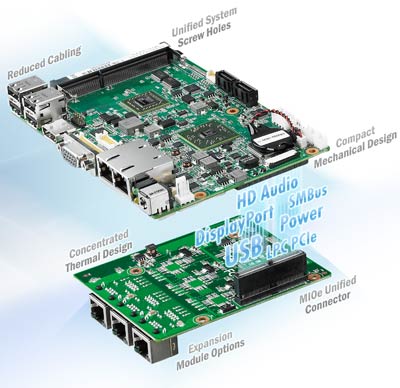 The disadvantage is that standards-based boards do not always support all interface requirements for a project, and despite the large number of board standards, there simply may not be one that fit special project needs. The disadvantage is that standards-based boards do not always support all interface requirements for a project, and despite the large number of board standards, there simply may not be one that fit special project needs.
To address this problem, Advantech created the MI/O Extension Single Board Computer. Conceptually, MI/O is between standard single board computers and configurable modules. It's in essence a single board computer with flexible multiple I/O support (hence the name MI/O).
What does the MI/O Extension standard mean for developers and system integrators? It means there is now a SBC standard that provides substantial additional versatility via MI/O extension modules that connect to the main board through standardized "MIO Unified Connector" high speed sockets.
This way, customers have flexible I/O choices to meet the needs of their vertical applications. Compatible with PCIe, USB 3.0, SATA and DisplayPort, MIOe facilitates a completely customized approach to meet any customer interface requirements. The image to the right shows a MI/O SBC and an expansion module.
Specifically, the MIOe unified extended interface connector common to all MI/O SBCs incorporates:
- DisplayPort
- 4 PCIe x1
- LPC
- SMBus
- 2 x USB 2.0
- USB 3.0
- HD audio line-out
- Power
MI/O boards come with the MIOe unified connector extended interface that connects in stacks, either to modules available from Advantech or to modules developed by clients using the Advantech's design guide. A white paper entitled "Innovative MI/O Extension Single Board Computer" is available here.
Two MI/O form factors
The compact MI/O Extension Single Board Computers come in two form factors, the Compact Series with a 146 x 102 mm form factor (a bit larger than COM-Express), and the Ultra Series with a 100 x 72 mm board size (same as Pico-ITX). There are, however, differences other than just board size between the two form factors.
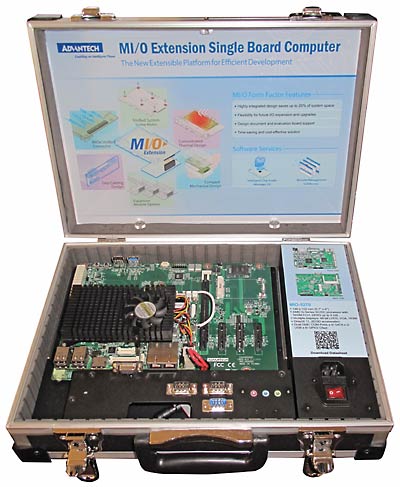 The Compact Series is designed for mid to high-end performance platforms with processor core thermal design powers (TDPs) in the 9 to 40 watt range. They may therefore include boards with up to standard voltage mobile Intel Core i3/i5/i7 processors and similar designs. The Compact Series also supports extended temperature design and comes with Advantech iManager chip that provides a standardized API for standard platform functions, and a self-management agent with software control functions (see iManager page and iManager white paper). The Compact Series is designed for mid to high-end performance platforms with processor core thermal design powers (TDPs) in the 9 to 40 watt range. They may therefore include boards with up to standard voltage mobile Intel Core i3/i5/i7 processors and similar designs. The Compact Series also supports extended temperature design and comes with Advantech iManager chip that provides a standardized API for standard platform functions, and a self-management agent with software control functions (see iManager page and iManager white paper).
The Ultra Series is for low-power applications where a small form factor and low pricing matter most. There is no onboard mini-PCIe expansion, space for a 2.5-inch hard disk, or DIP/SMT type I/O zone. This MIO class is for cores with thermal design powers of under 8 watts, which includes all current Intel Atom processors as well as many competing core designs.
Advantech's initial MI/O products are the MIO-5xxx Compact series and the MIO-2xxx Ultra series.
The picture to the right shows a Compact Series board inside a special MI/O platform demonstration case that explains and highlights the standard, and includes a MIO-5270 board, a carrier board, a power supply, and sample I/O expansion ports. Note that this is neither a computer nor a board, but simply a handy package assembled by Advantech to demonstrate the MIO platform.
Advantech MIO-5270
The Advantech MI/O demonstration case gave RuggedPCReview.com an opportunity to get a first look at the platform. The board included is Advantech's first product in the MIO-5xxx series, the MIO-5270. This is an SBC based on AMD's embedded G-Series of processors that include single core and dual core versions as well as DDR3 support up to 4GB. Our test board came with the top-of-the-line dual-core 1.65GHz AMD T56N CPU with a power draw of 8 (typical) to 16 watts (max).
Below you can see the top (left) and bottom (right) of the MIO-5270 board with its AMD T56N processor and A50M FCH chipset. Note that the top picture shows the active cooling sink that's part of the T56N configuration.
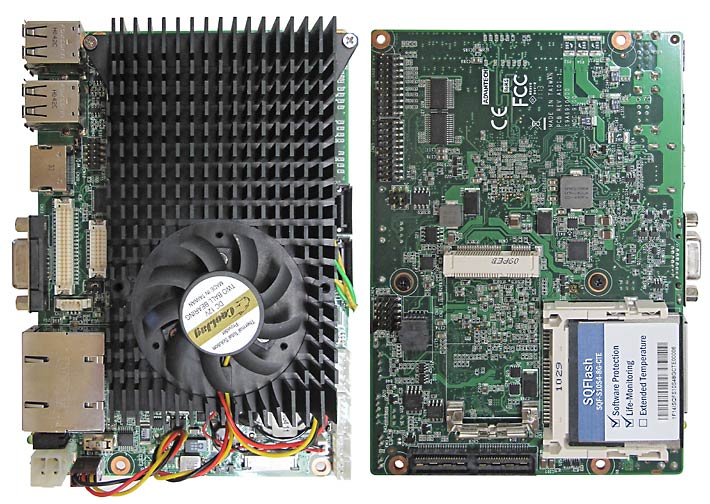
The picture below shows the MIO-5270's edge connector face with dual gigabit RJ45 LAN ports, four USB 2.0 ports, VGA, and HDMI. Visible on the underside of the board is the CF/CFast card slot.

Performance
Testing a CPU module or SBC is usually a bit trickier than testing a full mobile product (you just turn it on) or even a conventional motherboard (you connect a display, disk and keyboard). Having the MIO-5270 all set up with power and connected to a MOC-DB9000 carrier board made everything easy. All we had to do is connected a USB keyboard and mouse, and a flatscreen monitor for testing.
While this article is first and foremost an introduction of the MI/O standard, it's always interesting to see where products fit in performancewise, and so we installed Passmark Software's PerformanceTest 6.1 that runs about 30 tests covering CPU, 2D graphics, 3D graphics, memory, and disk and then computes scores for each category and an overall PassMark score. We also ran our second benchmark suite, CrystalMark, and listed the results together with the same benchmarks for four other (and very different) Advantech products with very different processors. The results are below.
|
Advantech MIO-5270 Benchmarks and Comparisons (PassMark 6.1, 32-bit version)
|
|
PERFORMANCE COMPARISON
|
Advantech
|
Advantech
|
Advantech
|
Advantech
|
Advantech
|
|
Model
|
MIO-5270
|
SOM-5890
|
SOM-6761
|
ARK-3403
|
PPC-157T
|
|
Type
|
MI/O Extension
|
COM-Express 2.0
|
COM
|
Box IPC
|
Panel PC
|
|
Processor Type:
|
AMD G-Series
|
Intel Core i7
|
Intel Atom
|
Intel Atom
|
Intel Core 2 Duo
|
|
Processor Model
|
T56N
|
2715
|
N270
|
D510
|
T7400
|
|
CPU Speed
|
1.65GHz
|
2.10GHz
|
1.60GHz
|
1.66GHz
|
2.16GHz
|
|
Thermal Design Power (TDP)
|
12 watts
|
45 watts
|
2.5 watts
|
13 watts
|
34 watts
|
|
CPU Mark
|
473.6
|
4,099.0
|
321.1
|
505.8
|
1,292.1
|
|
2D Graphics Mark
|
181.6
|
311.6
|
192.5
|
166.2
|
285.8
|
|
Memory Mark
|
205.3
|
795.8
|
199.1
|
230.0
|
552.3
|
|
Disk Mark
|
179.1
|
150.7
|
74.6
|
89.4
|
459.6
|
|
3D Graphics Mark
|
257.6
|
325.3
|
71.5
|
91.3
|
37.8
|
|
Overall PassMark
|
257.0
|
1,363.0
|
190.7
|
232.6
|
584.7
|
|
ALU
|
10,720
|
53,083
|
5,413
|
11,083
|
19,311
|
|
FPU
|
11,516
|
54,374
|
4,726
|
9,704
|
22,560
|
|
MEM
|
8,307
|
27,262
|
4,172
|
6,447
|
10,867
|
|
HDD
|
7,287
|
8.974
|
2,676
|
3,804
|
8,231
|
|
GDI
|
4,149
|
5,691
|
2,239
|
2,362
|
4,679
|
|
D2D
|
1,835
|
3,041
|
2,180
|
3,166
|
3,015
|
|
OGL
|
9,195
|
2,711
|
704
|
709
|
2,272
|
|
Overall CrystalMark
|
53,009
|
155,136
|
22,110
|
37,275
|
70,935
|
The above give you an idea where a high-end AMD G-Series MIO SBC fits in in terms of performance. It also gives an overall impression of relative performance of this AMD platform compares to Intel Atom and Intel Core based solutions. Overall, the MIO-5270 sits somewhere between Intel Atom and Intel Core 2 Duo. For sheer processor performance, the AMD T56N seems at about the Intel Atom D510 level. However, the AMD system is greatly aided by its potent ATI graphics subsystem that produced strong 3D and superior OGL graphics benchmarks.
Below is a schematic of the Advantech MIO-5270:
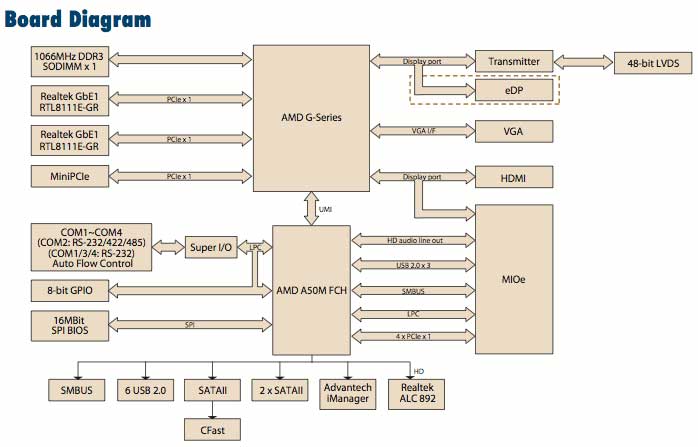
We're still very early in the life of the MI/O Extension Single Board Computer standard (which Advantech makes available to others as well). MI/O is in many respects similar to the PC104 standard with its stackable architecture, and has many of the same advantages. Add to that MI/O's special attention to optimal thermal design, minimal cabling, compact mechanicals and value-added integrated software services, and this new platform looks like a modern and promising solution in the integration-ready SBC space.
Advantech MIO-5270 Specs:
| Type |
MI/O Extension Single Board Computer
|
| CPU Type |
AMD G-Series T56N dual core, (also available: T40R single core, T40E dual core, T44R single core)
|
| Clock Speed |
1.65GHz (T40R/T40E: 1.0GHz; T44R: 1.2GHz)
|
| Chipset |
AMD G-Series
|
| BIOS |
AMI EFI 16Mbit
|
| Memory |
Max 4GB DDR3 1066/1333MHz in 1 204-pin SODIMM socket
|
| Graphics Controller |
AMD Radeon HD 6310 |
| VRAM |
unknown
|
| LVDS |
Supports single channel 24-bit or dual channel 48-bit LVDS (T56N: up to 2560 x 1600 @ 60 Hz; T40R/T40E/T44R up 1920 x 1200 @ 60 Hz)
|
| HDMI |
Supports HDMI v1.3, using TMDS data encoding 1920 x 1080 at 60 Hz, 36 bpp
|
| Dual display |
VGA + LVDS or VGA + HDMI or HDMI + LVDS
|
| LAN |
2 x 10/100/1000Base-T (both Realtek RTL8111E-VB-GR) |
| SATA |
2 x 300 MB/s SATA II |
| Expansion |
1 x Mini PCI Express, 1 x MI/O
|
| Cfast |
1
|
| SMBUS |
Supported
|
| SSD |
???
|
| USB |
6 x USB 2.0 (4 rear I/O, 2 internal)
|
| Serial |
3 x RS232, 1 x RS232/422/485 |
| Parallel |
NA |
| Audio |
Realtek ALC892, HD Audio, Line-in, Line out, Mic-in |
| GPIO |
8-bit general purpose input/output |
| Watchdog Timer |
NA
|
| Size |
146 mm x 102 mm (5.7" x 4.0")
|
| Weight |
0.85 kg (1.87 lb), weight of total package |
| Operating Temp. |
32 to 140F (0 to 60C)
|
| Price |
inquire
|
| Datasheet |
Advantech MIO-5270 |
Advantech Corporation
38 Tesla, Suite 100
Irvine, CA 92618
Toll Free: 1-800-866-6008
Ph: 949-789-7178
Fax: 949-789-7179
ECGInfo@advantech.com
www.advantech.com
Advantech Co. Ltd.
No.1, Alley 20, Lane 26, Rueiguang Road
Neihu District, Taipei Taiwan 114, R.O.C.
Tel: 886-2-2792-7818
Fax: 886-2-2794-7301
www.advantech.com
|



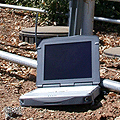

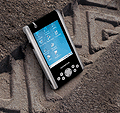
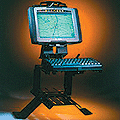





 The disadvantage is that standards-based boards do not always support all interface requirements for a project, and despite the large number of board standards, there simply may not be one that fit special project needs.
The disadvantage is that standards-based boards do not always support all interface requirements for a project, and despite the large number of board standards, there simply may not be one that fit special project needs.
 The Compact Series is designed for mid to high-end performance platforms with processor core thermal design powers (TDPs) in the 9 to 40 watt range. They may therefore include boards with up to standard voltage mobile Intel Core i3/i5/i7 processors and similar designs. The Compact Series also supports extended temperature design and comes with Advantech iManager chip that provides a standardized API for standard platform functions, and a self-management agent with software control functions (
The Compact Series is designed for mid to high-end performance platforms with processor core thermal design powers (TDPs) in the 9 to 40 watt range. They may therefore include boards with up to standard voltage mobile Intel Core i3/i5/i7 processors and similar designs. The Compact Series also supports extended temperature design and comes with Advantech iManager chip that provides a standardized API for standard platform functions, and a self-management agent with software control functions (

